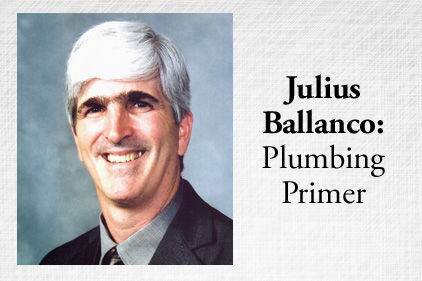Tips on controlling water pressure when needed
Too much pressure.


|
| Photo credit: ©istockphoto.com/TERADAT SANTIVIVUT |
One of the first things we learn in the plumbing profession is the allowable water pressure for a water distribution system. A maximum pressure of 80 psi was beat into my head at an early age. Some area of the country with high-rise buildings will allow up to 100 psi, while in other areas the pressure was lowered to 60 psi in an effort to conserve water.
The way we have controlled too much pressure is by installing a pressure-reducing valve, also called a pressure-control valve. When the valve gets larger, we change the name to an automatic control valve. The names are more semantics as both valves are designed to do the same thing — reduce the pressure in the water supply.
This is an area where all the plumbing codes do a lousy job. Every plumbing code states the pressure must be lowered. One of the plumbing codes attempts to help control the downstream pressure by requiring a pressure expansion tank. The justification is that if the water is heated, it will control thermal expansion. But what if the water isn’t heated downstream of the PRV? Why install an expansion tank?
We assume a PRV is going to work for the life of the building. Once installed, forget about it. That is a big mistake.
Like any active valve, a PRV will eventually need to be repaired or replaced. When it fails, the normal mode of failure is in the full open position. Hence, the pressure is no longer being reduced, the water distribution system will experience high pressure through a part of or the entire plumbing system.
This is where the havoc starts.
Too high a pressure can start blowing things apart in the plumbing system. I have seen many aerators blown out. I have seen ballcocks with the top blown off. I’ve even seen water closets cracked and leaking. Most systems have no protection in the event that a PRV fails.
Furthermore, most of the plumbing codes do not require such protection. Only one code requires a pressure-relief valve if the piping downstream of the reducing valve is not rated for the upstream pressure. Normally, the piping does meet the rating so no added protection is required. There is still the problem with things blowing apart.
Quite often, the protection against the high pressure is handled by the water heater. Every water heater has a temperature and pressure-relief valve to protect the heater from an explosion. However, the relief valve will open if the building water distribution pressure exceeds 150 psi.
Unlike an opening for protecting the water heater, if the PRV fails, the water heater relief valve will stay open until someone turns off the water supply. That may mean hours. It also may mean a lot of water damage if the drain near the relief valve cannot handle the large discharge of water.
Interestingly, the plumbing codes do not require a shutoff valve before a pressure-reducing valve. When water discharges from a failed PRV, you need to find the main shutoff to isolate the system.
Preventing water damage
You may be asking, “Shouldn’t the engineer be the one responsible for detailing a pressure control station?”
The answer is, “Yes.” Some engineers do a great job, while others don’t.
A shutoff valve always should be installed immediately upstream of any PRV. The shutoff valve also should be upstream of the strainer you install to protect the PRV. This allows you to isolate it for service or replacement and to clean the strainer.
Downstream of the shutoff valve are different options you can consider for providing protection from flooding. One of the easiest forms of protection is the installation of a pressure-relief valve. If you are reducing the pressure to below 80 psi, install a pressure-relief valve set for 100 psi. Be sure to have either a drain large enough in the area or direct the water to the outside of the building.
Engineers may specify an automatic control valve that is actually two valves. Manufacturers have different names for this category of valves. The first valve is a pressure-reducing valve. The second valve is a pressure-control valve that shuts off the supply of water in the event the PRV fails. Some of these valves also come equipped with a pressure-relief valve.
The beauty of these valves is they prevent water damage that could occur from high pressure in the water distribution system. This type of valve is often used in high-rise construction when the pressure upstream from the valve can be rather high. Just think what the pressure would be at the bottom of the Empire State Building without a PRV.
You can provide this level of protection with a series of valves. First, you would have a pressure-reducing valve with a pressure-relief valve downstream of the PRV. A solenoid-operated shutoff valve could be located upstream of the PRV with a probe installed in the relief valve drain. When the probe senses water, it shuts off the solenoid-operated shutoff valve.
Don’t install a PRV and expect it to work forever. You are better off having some form of protection in the event that the valve fails. If not, you may be paying the consequences later on when the building has extensive water damage.
If you are smart, you will make a note of every pressure-reducing valve you install. Depending on the water quality in your area, you can call the customer in three to seven years and recommend service for the PRV. It is good business for you, but it is better protection for your customer.
HELPFUL LINKS:
Looking for a reprint of this article?
From high-res PDFs to custom plaques, order your copy today!





